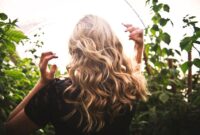I know, the world of natural hair care can feel overwhelming with endless tips and tricks. But, let's simplify it.
Have you ever wondered how to truly nourish your hair without all the fuss and chemicals? Well, I'm here to share some effective yet straightforward natural hair care tips that can transform your locks.
From understanding your hair type to embracing protective hairstyles, these tips will help you achieve healthy, luscious hair in no time.
Let's dive in and discover the best ways to care for your natural hair!
Key Takeaways
- Use sulfate-free products to maintain hair health and moisture balance.
- Deep condition regularly for intense hydration and repair.
- Embrace protective hairstyles to safeguard hair health and promote growth.
- Choose natural ingredients like argan oil for healthier, luscious locks.
Understanding Your Hair Type
When I assess my hair type, I observe its natural texture, thickness, and how it responds to different products and styling methods. Understanding hair porosity levels is crucial in determining how well your hair can absorb and retain moisture. Low porosity hair may struggle to absorb moisture, while high porosity hair can lose moisture quickly. Identifying your hair's porosity level helps in selecting the right products for optimal hydration.
Curl pattern identification is another essential aspect when understanding your hair type. Curls can range from straight to coily, and knowing your curl pattern aids in choosing suitable styling techniques and products. For instance, coily hair may benefit from heavier creams and butters to define curls, while straight hair might prefer lighter products that won't weigh it down.
Transitioning to Sulfate-Free Products
Transitioning to sulfate-free products is a crucial step in maintaining the health and vitality of your hair. Sulfates, such as sodium lauryl sulfate and sodium laureth sulfate, are harsh cleansing agents found in many shampoos. These ingredients can strip the hair of its natural oils, leading to dryness, frizz, and potential damage. By switching to sulfate-free products, you can protect your hair from unnecessary chemicals and help retain its moisture balance.
When transitioning to sulfate-free products, it's essential to be mindful of other potentially harmful ingredients in your hair care routine. Look for products that are free from parabens, silicones, and artificial fragrances to further promote the overall health of your hair. Incorporating natural ingredients like argan oil, shea butter, and aloe vera can provide nourishment and hydration without the use of harsh chemicals.
Incorporating Deep Conditioning Treatments
To maintain optimal hair health and nourishment, it's essential to incorporate deep conditioning treatments into your routine. Deep conditioning treatments provide intense hydration and nourishment to your hair, helping to repair damage, improve elasticity, and promote overall hair health. DIY treatments can be a fantastic option, as they allow you to tailor the ingredients to suit your specific hair needs. These treatments often contain natural oils, proteins, and vitamins that work to strengthen and moisturize your hair.
The benefits of deep conditioning treatments are numerous. They help to restore moisture, reduce breakage, and enhance the overall appearance and feel of your hair. Additionally, regular deep conditioning can aid in preventing heat damage, which is crucial for maintaining the health of your hair, especially if you use heat styling tools frequently. By incorporating deep conditioning treatments into your hair care routine, you can enjoy stronger, healthier, and more luscious locks.
Embracing Protective Hairstyles
Embracing protective hairstyles is a key strategy in safeguarding the health and integrity of natural hair. These hairstyles offer a range of benefits, including protecting the hair from environmental damage, reducing manipulation and breakage, and promoting hair growth and length retention. When choosing protective styles, it's essential to consider various styling options that suit your hair type and preferences.
Braids, twists, buns, and wigs are popular protective styles that can help in maintaining the moisture balance of your hair and preventing excessive dryness. Additionally, these styles provide a break from daily styling routines that may contribute to hair damage over time.
To maximize the benefits of protective hairstyles, it's crucial to ensure that your hair is properly moisturized and cared for underneath the style. Regularly moisturizing your scalp and hair, keeping your hair clean, and avoiding styles that are too tight are essential practices to promote healthy hair growth and length retention while rocking your favorite protective styles.
Maintaining Moisture Balance
Maintaining moisture balance in natural hair is crucial for overall hair health and vitality, especially when rocking protective hairstyles. To prevent breakage and keep your hair hydrated, focus on a few key practices.
First, choose a moisturizing shampoo and conditioner that cater to your hair's specific needs. Look for products with natural oils like coconut or argan oil to help hydrate and nourish your strands from root to tip.
Deep conditioning regularly is also essential to maintain moisture levels and strengthen your hair. Consider using a hair mask once a week to provide an extra boost of hydration.
Additionally, incorporating a leave-in conditioner can help lock in moisture throughout the day, especially at the ends of your hair, which tend to be more prone to dryness and breakage.
Frequently Asked Questions
Are There Any Specific Diet Recommendations for Promoting Healthy Natural Hair Growth?
For promoting healthy natural hair growth, it's essential to focus on nutrient intake. A balanced diet rich in vitamins, minerals, and proteins is key. Incorporating foods like spinach, avocados, and nuts can help nourish hair follicles and support hair growth.
How Often Should I Trim My Natural Hair to Prevent Split Ends and Breakage?
I trim my natural hair every 8-12 weeks to prevent split ends and breakage. Opting for protective styles like braids or twists in between trims helps maintain hair health. Regular trims are key to keeping my hair strong and healthy.
Is It Necessary to Use Heat Styling Tools on Natural Hair, or Are There Alternative Methods for Achieving Different Hairstyles?
Avoiding heat styling on natural hair can maintain its health. Embrace heat-free styling like protective hairstyles, utilize hair accessories, and nourish with hair masks. These alternatives preserve your hair's natural beauty and vitality.
Are There Any Specific Environmental Factors or Lifestyle Habits That Can Affect the Health of Natural Hair?
Living in areas with high environmental pollution can impact hair health. Weather conditions affect hair porosity. Lifestyle choices like diet and stress levels also play a role. Understanding these factors helps in creating a holistic natural hair care routine.
What Are Some Common Misconceptions About Natural Hair Care That I Should Be Aware Of?
Common myths about natural hair care often revolve around needing expensive products. However, proper hydration is key. Misconceptions like needing to wash daily or avoiding oils can hinder hair health. Knowledge is power.
Conclusion
In conclusion, following these natural hair care tips will surely lead to healthy and vibrant hair.
It's ironic how simple changes can make a big difference in your hair's appearance and overall health.
So, don't underestimate the power of natural ingredients and simple routines. Trust me, your hair will thank you in the long run!



